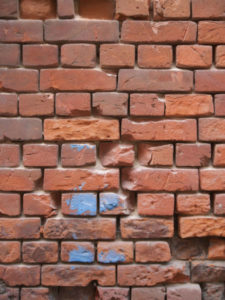Chimneys can really stand the test of time. Some of the oldest chimneys in the world are located in Virginia, and it’s pretty obvious that these chimneys were built to last. But even these sturdy structures are susceptible to the wearing effects of outdoor elements, especially precipitation. Whether a light spring rain or the cold sleet of winter, precipitation can have a devastating effect on your chimney. Another thing that can damage the mortar of your chimney is burning a fire in your fireplace. Unfortunately, even using your fireplace for its intended purpose can have a deteriorating effect on your chimney. It’s important to know what to look for so that you can avoid expensive and time-consuming repairs.
 Precipitation and Mortar
Precipitation and Mortar
First let’s look at precipitation. When water gets into your chimney, it can mix with the gases that are released when you burn a fire in your fireplace. This mixture is corrosive, and when it gets on the brick and mortar of your chimney, it can eat away at these materials and cause structural damage to occur. Not only that, but when the weather turns cold, the freeze/thaw cycle will take place. Mortar is very porous, and when it rains, the moisture gets into those pores and freezes. When water freezes, it expands, and that means that the pores get bigger. As this happens, you can be looking at big repair bills to fix the deterioration that occurs.
One way to determine if your chimney has water damage is as simple as taking a visual inventory of your chimney on the outside of your house. If you notice that there is flaking, peeling, or other visible wearing away of the mortar, this means that spalling is occurring. If you see spalling, you should call your chimney inspection and repair company before the damage gets more severe.
Fire Damage
Although it may seem odd, burning a fire in your fireplace can actually cause damage to the mortar of your chimney. When you burn wood, several different chemicals are released and go up your chimney in the form of smoke. However, when this reaches the top of your chimney where it’s cooler, it will condense on the bricks and mortar in the form of creosote. Creosote is extremely flammable, and when sparks from a fire reach it, a chimney fire can occur. At times, these fires can go undetected, and this can cause a dangerous situation because you may unknowingly have a breakdown in the structure of the chimney which will lead to further damage.
Unlike spalling, if an undetected chimney fire has occurred, it won’t be visible to the untrained eye. Your best line of defense is to call in a certified specialist like those at Old Dominion Chimneys.
Professional Service
It’s important to keep your chimney in top working order, especially if it’s an older chimney. Call Old Dominion Chimneys to inspect your chimney today. They will be able to advise you on and make any necessary repairs in an efficient and timely manner. You can trust Old Dominion with all your chimney needs.


Recent Comments